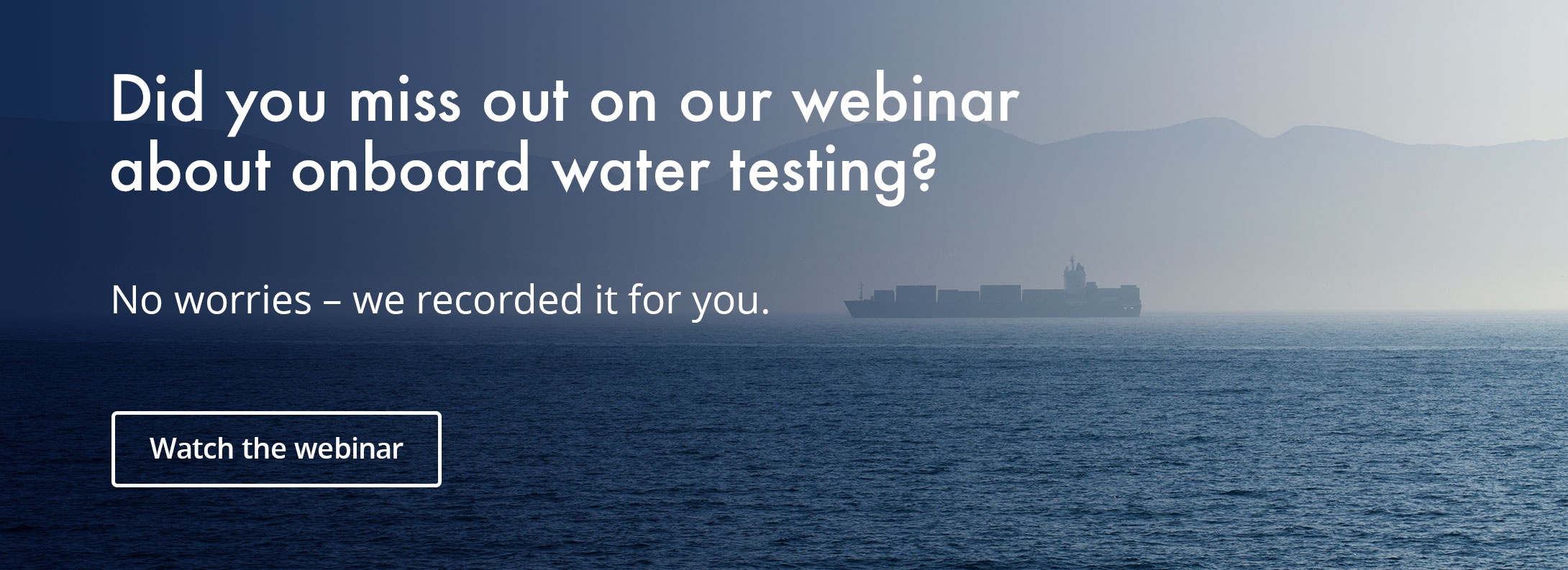If price is your only consideration when selecting a water test kit, you’ll probably end up paying more than needed.
In shipping, time is of the essence. The goal is to do the job as efficiently as possible, yet many shipowners set themselves up for detours and costly delays.
Water testing on board is a regulatory required task that can impact health, safety and the environment. Let’s look at how you can cut costs in your water testing routines.
Why We Test Water Onboard
First of all, a quick reminder of why we test our onboard water. Testing is done to ensure safe drinking water, environment friendly discharge or functional integrity.
Why you need to test water on board |
||||
|
Potable water |
Ballast water |
Sewage effluent |
Cooling & boiling water |
|
|
Safeguard your crew |
✔️ |
– |
– |
– |
|
Protect the environment |
✔️ |
✔️ |
✔️ |
✔️ |
|
Comply with regulations |
IMO, FDA equivalents in local territories |
IMO |
IMO, MARPOL Annex IV |
– |
We’re not concerned with pin-point accuracy at sea. Testing of onboard water is based on indication; is the value within the desired range? Contaminants not only threaten crew or the environment: Exceeding the regulatory limits may disqualify you from sailing
A word on crew safety: Test kits for potable water are designed to determine the water quality, enabling you to react quickly in the event of e.g. a Legionella outbreak. Periodic testing ensures early intervention, helping you avoid further harm.
Read more: Water Testing On Board Ships: How to Achieve Compliance
Comparing Test Methods
There are two main methods for testing water: manual and digital. Test results from both kits are indicative. Values within the permitted range implies you are ready to sail. However, should the values exceed the accepted levels, the samples have to be sent to shore for comprehensive analysis at a certified testing lab. This applies to both test methods.
There are pros and cons with both test-kits, and one is strongly preferred over the other. Let’s take a closer look.
Stop or go? An indicative test tells you whether your sample is within the permitted range or not.
Manual Test Kits: Prone to Error and Labour Intensive
Manual test kits consist of petri dishes, test tubes, and various other components for sampling and analysis. Crew members sample the water in question, and, dependent on the microorganism in question, perform manual analysis of the samples.
Some microorganism levels are best evaluated via incubation in petri dishes, others colorimetrically (the population is correlated to colour indicators). The pH value is determined visually by placing a sample on a piece of pH paper.
Analogue kits are inexpensive, but sampling and testing can be challenging. The sea is notoriously unstable, and accurate sampling requires a steady hand. Thus, sample contamination is a common problem, and the analysis can also be difficult. Colorimetry precision requires satisfactory lighting conditions, and two different people might interpret the sample differently.
Contamination risk and low-precision analysis can lead to false positives. That can force you to send wrongly interpreted samples ashore for lab analysis – leaving crew, vessel and cargo waiting. This leads to time-consuming delays, which drives costs.
Below is a summary of the pros and cons.
Pros:
- Manual kits are inexpensive to purchase.
Cons:
- Manual sampling and analysis is time consuming and difficult.
- Manual samples are prone to contamination – increased risk of false positives.
- Consumables are single-use.
Manual water sampling requires a steady hand.
Digital Test Kits – Effortless Precision
A digital test kit contains digital instruments and accessories for every relevant microorganism. It consists of a padded briefcase, equipment and consumables. In contrast to the manual kit, the centrepiece of the digital kit – the digital instrument – can be used again and again.
Pros:
- Saves time: The instrument almost instantly produces a reading.
- Precision: You get unambiguous, numerical results.
- Operation friendly: Easy to to handle and little training required.
Cons:
- Slightly higher investment costs.
This Potable Water Test Kit contains everything you need, and it produces the results in an instant.
Digital Kits From a Proactive Partner Yields Optimal Water Testing
Manual test kits appeal to many shipowners because of their low cost of purchase. However, water testing should be evaluated on the basis of total cost. There will always be individual circumstances to consider, but most shipowners will benefit from saving time and labour. That’s where digital test kits are in a league of their own.
The digital test kit approach, coupled with a partner who keeps track of, and automatically replenishes your stock of consumables, is the way to achieve optimal test reliability with the least amount of effort.


